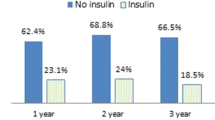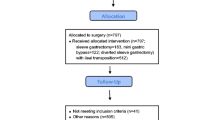Abstract
Background
This study was to compare the effect of intensive insulin therapy (IIT) to conventional insulin therapy (CIT) on postoperative outcomes among type 2 diabetes mellitus (DM) patients who underwent D2 gastrectomy for gastric cancer.
Methods
We randomly assigned gastric cancer patients with type 2 DM who underwent radical gastrectomy to receive IIT (maintenance of blood glucose at a level between 4.4 and 6.1 mmol/l) with insulin infusion or CIT (maintenance of blood glucose at a level between 10 and 11.1 mmol/l) during the postoperative period.
Results
Of the 179 eligible patients, 92 patients were assigned to receive IIT and 87 patients to receive CIT. Mean blood glucose concentrations were lower in the intensive group (IG) than in the conventional group (CG) (5.5 ± 0.8 vs. 9.9 ± 1.0 mmol/l, P < 0.001). Hypoglycemia occurred in 6 patients (6.5%) in the IG (P = 0.029) versus in 1 patient (1.1%) in the CG. Hospital mortality did not differ significantly between two groups (4.3% vs. 5.7%, P = 0.742). However, IIT significantly reduced morbidity (from 18.4 to 7.6%, P = 0.031). Also, IIT shortened the days to suture removal, postoperative hospital stay, and postoperative duration of antibiotic use. The HOMA-IR score was lower at all time points in IG. Moreover, IIT increased the postoperative HLA-DR expression on monocytes on postoperative days 3 and 5.
Conclusions
IIT significantly reduced short-term morbidity but not mortality among type 2 DM patients who underwent D2 gastrectomy for gastric cancer. Furthermore, a possible mechanism of suppression of the insulin resistance and improvement of HLA-DR expression may partially explain the benefits of IIT.


Similar content being viewed by others
References
Ouattara A, Lecomte P, Le Manach Y et al (2005) Poor intraoperative blood glucose control is associated with a worsened hospital outcome after cardiac surgery in diabetic patients. Anesthesiology 103:687–694
Furnary AP, Gao G, Grunkemeier GL et al (2003) Continuous insulin infusion reduces mortality in patients with diabetes undergoing coronary artery bypass grafting. J Thorac Cardiovasc Surg 125:1007–1021
Lazar HL, Chipkin SR, Fitzgerald CA et al (2004) Tight glycemic control in diabetic coronary artery bypass graft patients improves perioperative outcomes and decreases recurrent ischemic events. Circulation 109:1497–1502
van den Berghe G, Wouters P, Weekers F et al (2001) Intensive insulin therapy in the critically ill patients. N Engl J Med 345:1359–1367
Ascione R, Rogers CA, Rajakaruna C et al (2008) Inadequate blood glucose control is associated with in-hospital mortality and morbidity in diabetic and nondiabetic patients undergoing cardiac surgery. Circulation 118:113–123
van den Berghe G, Wilmer A, Hermans G et al (2006) Intensive insulin therapy in the medical ICU. N Engl J Med 354:449–461
Finfer S, Chittock DR, Su SY et al (2009) Intensive versus conventional glucose control in critically ill patients. N Engl J Med 360:1283–1297
Lipshutz AK, Gropper MA (2009) Perioperative glycemic control: an evidence-based review. Anesthesiology 110:408–421
Cao SG, Zhou YB, Zhang CK et al (2008) Effect of intensive insulin therapy on the clinical results of postoperative patients with gastric cancer. Chinese J Surg 46:918–920
World Health Organization (1999) Definition, diagnosis and classification of diabetes mellitus and its complications, part 1: diagnosis and classification of diabetes mellitus: report of the WHO consultation. WHO, Tech. Rep. Ser. No. WHO/NCD/NCS/99.2, Geneva
Furnary AP, Zerr KJ, Grunkemeier GL et al (1999) Continuous intravenous insulin infusion reduces the incidence of deep sternal wound infection in diabetic patients after cardiac surgical procedures. Ann Thorac Surg 67:352–360
Kajitani T (1981) The general rules for the gastric cancer study in surgery and pathology. Part I. Clinical classification. Jpn J Surg 11:127–139
Emoto M, Nishizawa Y, Maekawa K et al (1999) Homeostasis model assessment as a clinical index of insulin resistance in type 2 diabetic patients treated with sulfonylureas. Diabetes Care 22:818–822
Bonora E, Targher G, Alberiche M et al (2000) Homeostasis model assessment closely mirrors the glucose clamp technique in the assessment of insulin sensitivity: studies in subjects with various degrees of glucose tolerance and insulin sensitivity. Diabetes Care 23:57–63
Mohn A, Marcovecchio M, Chiarelli F (2006) Validity of HOMA-IR as index of insulin resistance in obesity. J Pediatr 148:565–566; author reply 566
Bonora E, Formentini G, Calcaterra F et al (2002) HOMA-estimated insulin resistance is an independent predictor of cardiovascular disease in type 2 diabetic subjects: prospective data from the Verona Diabetes Complications Study. Diabetes Care 25:1135–1141
Bone RC, Sibbald WJ, Sprung CL (1992) The ACCP-SCCM consensus conference on sepsis and organ failure. Chest 101:1481–1483
Yamashita S, Yamaguchi H, Sakaguchi M et al (2000) Longer-term diabetic patients have a more frequent incidence of nosocomial infections after elective gastrectomy. Anesth Analg 91:1176–1181
van den Berghe G, Wilmer A, Milants I et al (2006) Intensive insulin therapy in mixed medical/surgical intensive care units: benefit versus harm. Diabetes 55:3151–3159
Wiener RS, Wiener DC, Larson RJ (2008) Benefits and risks of tight glucose control in critically ill adults: a meta-analysis. JAMA 300:933–944
Mesotten D, Swinnen JV, Vanderhoydonc F et al (2004) Contribution of circulating lipids to the improved outcome of critical illness by glycemic control with intensive insulin therapy. J Clin Endocrinol Metab 89:219–226
Mesotten D, Delhanty PJ, Vanderhoydonc F et al (2002) Regulation of insulin-like growth factor binding protein-1 during protracted critical illness. J Clin Endocrinol Metab 87:5516–5523
Wang QG, Lu LF, Zhou YB et al (2008) Effects of intensive insulin therapy on insulin resistance and serum proteins after radical gastrectomy. Chinese J Gastrointest Surg 11:444–447
Vanhorebeek I, De Vos R, Mesotten D et al (2005) Protection of hepatocyte mitochondrial ultrastructure and function by strict blood glucose control with insulin in critically ill patients. Lancet 365:53–59
Hansen TK, Thiel S, Wouters PJ et al (2003) Intensive insulin therapy exerts antiinflammatory effects in critically ill patients and counteracts the adverse effect of low mannose-binding lectin levels. J Clin Endocrinol Metab 88:1082–1088
Weekers F, Giulietti AP, Michalaki M et al (2003) Metabolic, endocrine, and immune effects of stress hyperglycemia in a rabbit model of prolonged critical illness. Endocrinology 144:5329–5338
Thorell A, Nygren J, Hirshman MF et al (1999) Surgery-induced insulin resistance in human patients: relation to glucose transport and utilization. Am J Physiol 276:E754–E761
Bandyopadhyay G, De A, Laudanski K et al (2007) Negative signaling contributes to T-cell anergy in trauma patients. Crit Care Med 35:794–801
Tschaikowsky K, Hedwig-Geissing M, Schiele A et al (2002) Coincidence of pro- and anti-inflammatory responses in the early phase of severe sepsis: longitudinal study of mononuclear histocompatibility leukocyte antigen-DR expression, procalcitonin, C-reactive protein, and changes in T-cell subsets in septic and postoperative patients. Crit Care Med 30:1015–1023
Walsh DS, Thavichaigarn P, Pattanapanyasat K et al (2005) Characterization of circulating monocytes expressing HLA-DR or CD71 and related soluble factors for 2 weeks after severe, non-thermal injury. J Surg Res 129:221–230
Mochiki E, Ohno T, Kamiyama Y et al (2005) Laparoscopy-assisted gastrectomy for early gastric cancer in young and elderly patients. World J Surg 29:1585–1591
Huscher CG, Mingoli A, Sgarzini G et al (2005) Laparoscopic versus open subtotal gastrectomy for distal gastric cancer: five-year results of a randomized prospective trial. Ann Surg 241:232–237
Acknowledgment
This study was partially supported by the Health Science and Technology Development Project of Shandong (2005HZ024).
Conflict of interest
There is no potential and real conflict to any third party.
Author information
Authors and Affiliations
Corresponding author
Rights and permissions
About this article
Cite this article
Cao, SG., Ren, JA., Shen, B. et al. Intensive Versus Conventional Insulin Therapy in Type 2 Diabetes Patients Undergoing D2 Gastrectomy for Gastric Cancer: A Randomized Controlled Trial. World J Surg 35, 85–92 (2011). https://doi.org/10.1007/s00268-010-0797-5
Published:
Issue Date:
DOI: https://doi.org/10.1007/s00268-010-0797-5




